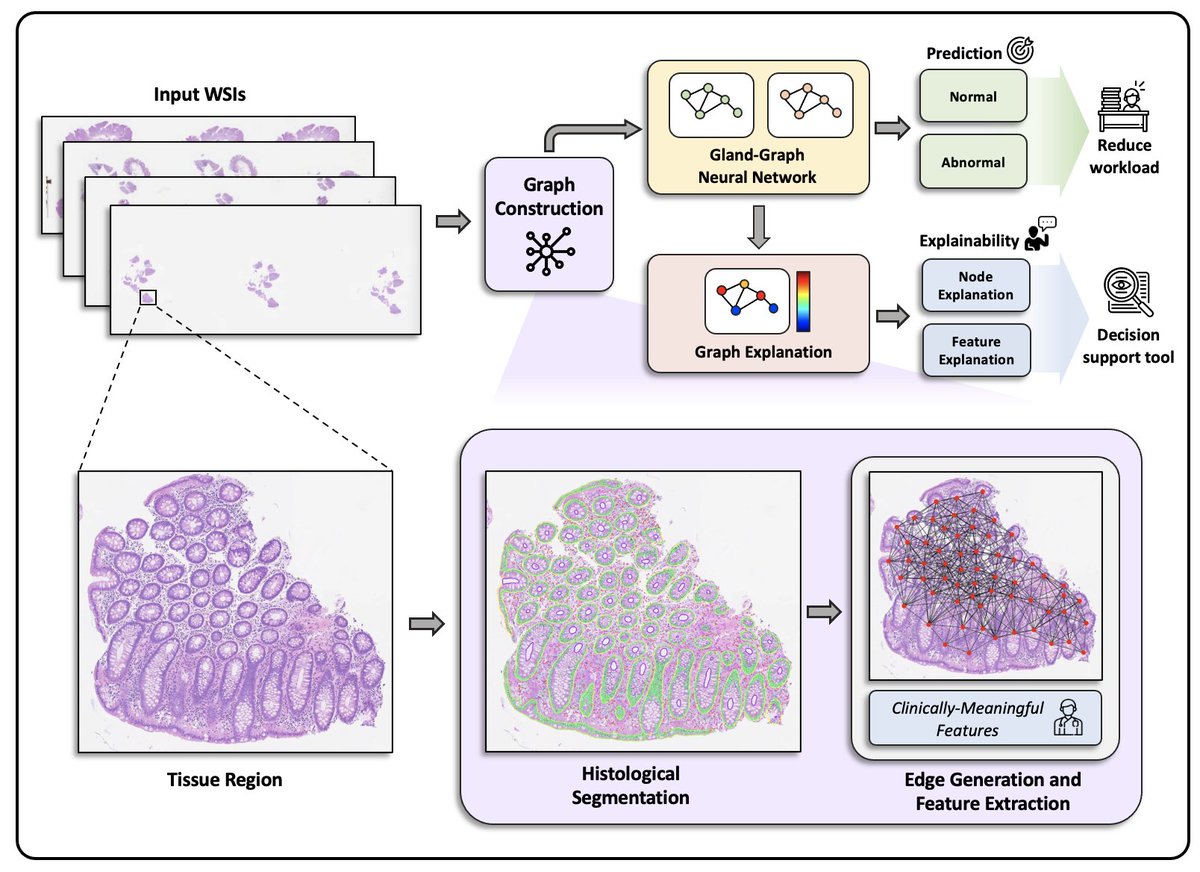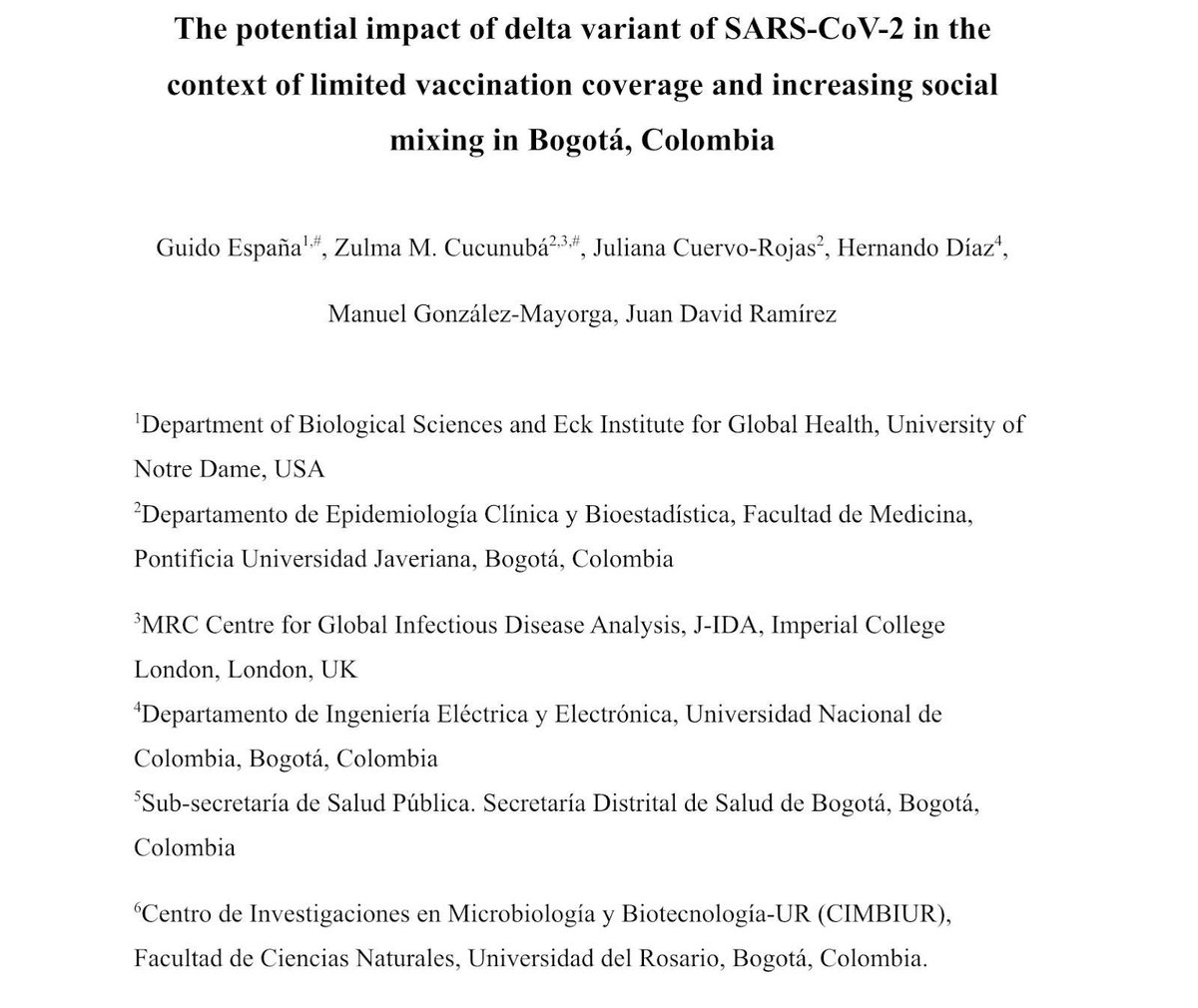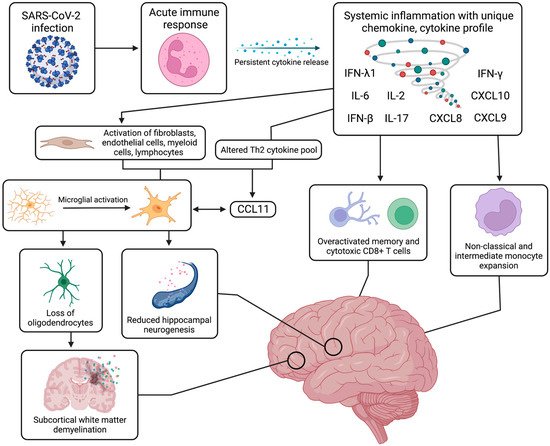Discover and read the best of Twitter Threads about #preprint
Most recents (24)
#Guthilo 🧶 no apto para antivacunas
¿La vacuna contra el herpes zoster reduce el riesgo de demencia? R/Si
#preprint
Evidencia causal de que la 💉contra el herpes zoster previene una proporción de casos de demencia 🧠 @PGeldsetzer1
medrxiv.org/content/10.110…
¿La vacuna contra el herpes zoster reduce el riesgo de demencia? R/Si
#preprint
Evidencia causal de que la 💉contra el herpes zoster previene una proporción de casos de demencia 🧠 @PGeldsetzer1
medrxiv.org/content/10.110…
A lo largo de la hisroria hemos prestado poca atención a los inquilinos (patógenos) q habitan en nuestro cuerpo sin pagar alquiler⤵️
Las causas fundamentales de la demencia aún no están claras en gran medida, y la comunidad médica carece de agentes farmacéuticos preventivos y terapéuticos altamente efectivos para la demencia a pesar de las grandes inversiones en su desarrollo.
#preprint
👉Mayor riesgo de cáncer de colon después de una apendicitis aguda: un estudio nacional basado en la población
papers.ssrn.com/sol3/papers.cf…
👉Mayor riesgo de cáncer de colon después de una apendicitis aguda: un estudio nacional basado en la población
papers.ssrn.com/sol3/papers.cf…
En este estudio basado en la población, encontraron que la apendicitis aguda parece ser una señal de advertencia de cáncer de colon (causalidad inversa) tanto en adultos de mediana edad como jóvenes.
Usaron la base de datos de alta hospitalaria francesa (PMSI), incluyeron a todos los pacientes de 18 a 59 años que presentaron apendicitis aguda entre 2010 y 2015
Un total de 230.512 pacientes con apendicitis aguda.
Un total de 230.512 pacientes con apendicitis aguda.
Our latest paper describing #universal #CoV vaccine that can protect against #MERSCoV and #SARSCoV is now out in #preprint @YaleMed
Short thread 👇🏼
“Vaccine-mediated protection against merbecovirus and sarbecovirus challenge in mice” biorxiv.org/content/10.110…
Short thread 👇🏼
“Vaccine-mediated protection against merbecovirus and sarbecovirus challenge in mice” biorxiv.org/content/10.110…
We were interested in developing vaccination strategies against highly pathogenic human #coronaviruses with epidemic potential. Our previous studies, and those of others, defined the #RBD as a major target of neutralizing antibodies.
Pathogenèse sous-jacente aux manifestations neurologiques du syndrome de #covidlong et thérapeutiques potentielles - récent #préprint ⤵️
mdpi.com/2073-4409/12/5…
Merci @Drferremd - et @ejustin46
pour le relais.
1/
mdpi.com/2073-4409/12/5…
Merci @Drferremd - et @ejustin46
pour le relais.
1/
Neuroinvasion & excrétion virale persistante.
#SARSCoV2 utilise le récepteur ACE2 pr envahir les cellules souches, périvasculaires, sustentaculaires & de la glande de Bowman ds l'épithélium olfactif, d'où 1 amincissement chronique des filia & une ↘️ de volume du bulbe olfactif.
2
#SARSCoV2 utilise le récepteur ACE2 pr envahir les cellules souches, périvasculaires, sustentaculaires & de la glande de Bowman ds l'épithélium olfactif, d'où 1 amincissement chronique des filia & une ↘️ de volume du bulbe olfactif.
2

#covidlong : un #préprint sur les patients ayant notamment comme #séquelles des #céphalées #chroniques
Résumé :
Près de 20 % des patients atteints de #COVID19 présentent des effets à long terme, connus sous le nom d'état post-COVID ou covidlong.
1/
biorxiv.org/content/10.110…
Résumé :
Près de 20 % des patients atteints de #COVID19 présentent des effets à long terme, connus sous le nom d'état post-COVID ou covidlong.
1/
biorxiv.org/content/10.110…
Parmi les nombreux symptômes neurologiques persistants, les maux de tête chroniques sont les plus courants. Malgré ce problème de santé, l'étiologie des céphalées du long COVID n'est pas encore bien caractérisée. Nous présentons ici une analyse longitudinale de
2/
2/
la transcriptomique des leucocytes sanguins, de la protéomique plasmatique et de la métabolomique de patients souffrant de céphalées chroniques à long COVID. Les patients atteints de COVID long ont connu un état d'hyperinflammation avant l'apparition des céphalées chroniques
3/
3/
new #preprint, @OSFramework , happy to have this out the door, been working on it for a while.
"Darwin’s Agential Materials: evolutionary implications of multi-scale competency in developmental biology"
osf.io/p23se/


"Darwin’s Agential Materials: evolutionary implications of multi-scale competency in developmental biology"
osf.io/p23se/



In prior papers, I argued for morphogenesis as a kind of collective intelligence navigating anatomical morphospace with various competencies. I proposed a few ways in which evolution scales up from single cells' tiny goals to agents with larger goals (e.g., specific target 

morphologies). Here, I ponder the flip side of the intelligence-evolution feedback loop: what does the competency of the morphogenetic layer mean for the evolutionary process itself? What might be the ways in which evolution works over an agential material? Check out the
🚨🚨I'm proud to present our lab's first peer-reviewed paper, out at @cellhostmicrobe🥳. We started out by asking a basic question about mucus secretion, and discovered something surprising about genetic risk to inflammatory bowel diseases (#IBD). A🧵/1
cell.com/cell-host-micr…
cell.com/cell-host-micr…
Every cell that secretes something needs to have some kind of control over how much it secretes. We asked how goblet cells in the intestine "know" how much mucus they need to secrete. I wrote about it here when we published our #preprint 👇🏻. /2
We found that ER stress is the cell-intrinsic switch that tells the goblet cell when to stop producing mucus, and that autophagy is tasked with relieving this stress to allow secretion. /3
New #preprint alert! What are the core symbionts of lichens? TLDR: we analyzed >400 lichen metagenomes from around the world and found that 4 bacterial groups are as frequent in lichens as the alga, one of the two main partners in the symbiosis. 🧵1/11 biorxiv.org/content/10.110… 

We aimed to create a global census of lichen-associated organisms based on shotgun metagenomics, and independent from biases associated with culturing and PCR amplification. We used nearly every publicly available lichen metagenome plus de novo data 2/11
#Studie der #HarvardMedicalSchool, Boston:
"Kinder im Alter von 10 bis 19 Jahren spielten die größte relative Rolle bei der Verbreitung von Omicron-Epidemien, insbesondere wenn Schulen geöffnet waren, gefolgt von Kindern im Alter von 0 bis 9 Jahren ..."
#BildungAberSicher 🧵
"Kinder im Alter von 10 bis 19 Jahren spielten die größte relative Rolle bei der Verbreitung von Omicron-Epidemien, insbesondere wenn Schulen geöffnet waren, gefolgt von Kindern im Alter von 0 bis 9 Jahren ..."
#BildungAberSicher 🧵
"... und Erwachsenen im Alter von 20 bis 29 Jahren sowie Erwachsenen im Alter von 30 bis 49 Jahren. Personen im Alter von über 50 Jahren spielten bei der Ausbreitung der Omicron-Infektion in der Gemeinschaft eine geringere Rolle."
2/
2/
"Es sind zusätzliche Anstrengungen erforderlich, um die Durchimpfungsrate bei Kindern im Alter von 10 bis 19 Jahren sowie bei jüngeren Kindern und jungen Erwachsenen zu erhöhen, um Omicron-Epidemien in der Gemeinschaft einzudämmen."
3/
3/
We have a new #preprint out! It’s about what happens in your ears when your eyes move. A #tweeprint about @Stephschlebusch, @cindyking40, David L.K. Murphy et al. 1/
First some background: A couple years ago, we (Gruters, Murphy et al.) discovered that your ears *make* tiny sounds when your eyes move. See theatlantic.com/science/archiv… by @edyong209 2/
We are thrilled to share #Starfysh ⭐️ an auxiliary deep generative model for multi-modal analysis and integration of spatial transcriptomic (ST) datasets and histology images, and its application to heterogeneous #breastcancer tumors! 😃 tinyurl.com/hffdhvx7 1/ 

Incredibly fortunate to have a passionate, collaborative & talented team that didn't slow down with all the challenges of the past few years 🙏: @SiyuHe7 @YinuoJin6, @AchilleNazaret @shi_lingting and a fruitful and ongoing collaboration with @GeorgePlitas and Sasha Rudensky. 2/
Using ST, we wanted to find out if our previously observed continuous phenotypic expansion of intratumoral immune states (doi.org/10.1016/j.cell…) could be explained by the #spatialdynamics of immune cells and exposure to different environmental signals and nutrient supply? 🧐 3/
特に新しい情報でもないけど・・・
Covid-19感染は心血管系の予後不良および死亡と関連する
Covid-19 Infection Linked With Poor Cardiovascular Outcomes And Death via @Forbes forbes.com/sites/williamh…
Covid-19感染は心血管系の予後不良および死亡と関連する
Covid-19 Infection Linked With Poor Cardiovascular Outcomes And Death via @Forbes forbes.com/sites/williamh…
英国の新しい研究により、Covid-19に感染すると、心血管系の健康状態の悪化や死亡のリスクが増加することが示された。このリスクは、感染後30日以内と入院が必要な感染者の間で最も高いが、重度の感染を経験しなかった人々にもリスクは高いままである。
forbes.com/sites/williamh…
forbes.com/sites/williamh…
ウイルスに感染していない対照群と比較すると、Covid-19に感染した人は静脈に血栓ができる可能性が3倍高く、何らかの原因で死亡する可能性も10倍以上あった。
forbes.com/sites/williamh…
forbes.com/sites/williamh…
[1/5] How can we improve pathologist efficiency in screening of normal colon biopsies? Take a look at our new #preprint that tackles this issue using #interpretable #AI 🔬 🚀 @PathLAKE_CoE
medrxiv.org/content/10.110…
medrxiv.org/content/10.110…

@PathLAKE_CoE @jnkath @AI4Pathology @NormanZerbe @anantm @mitkoveta @olkazuraw @GuillaumeJaume @pushpak_pati @jana_lipkova @nadeem_lab [2/5] Our approach, named #IGUANA, uses #pathologist-derived #interpretable features within a geometric learning framework to categorise biopsies as normal or abnormal (containing both non-neoplastic and neoplastic conditions).
[3/5] IGUANA achieves 0.98 AUC-ROC on an internal cohort and 0.97 AUC-ROC on three external cohorts. Our analysis shows that at a high sensitivity threshold of 99%, the proposed model can, on average, reduce the number of normal slides to be reviewed by a pathologist by 55%.
Jan Bonte “Neuroloog” @the_stinging heeft een column: Vraag het Marion. De inhoud toont dat je idd 1000 x beter bij @MarionKoopmans te rade kunt gaan dan bij Jan. Zijn laatste bijdrage is gewauwel over de #Lableak theorie. Tijd om dit eens onderuit te halen… #debunk 🧵. 1/19
Hij begint met de claim dat aanhangers van de #zoönose en #lableak theorie recht tegenover elkaar staan. Dat kan zo zijn maar dan staan er 1000 mensen links en 2 mensen rechts (Jan telt tenslotte voor 2 #cholesterolbol) 2/19
Daarbij dropt hij direct een verdachtmaking. De wetenschap zou bang zijn dat Gain of Function (GoF) onderzoeken worden gestaakt als het toch een #lableak was en daarom zijn ze zo fel. Ik zeg verdachtmaking want er is hiervoor geen enkel bewijs. 3/19
Do you spend time inside? OF COURSE YOU DO! You should check out our paper that looks at the amount of #coronavirus #sarscov2 #COVID19 in rooms with COVID+ individuals
nature.com/articles/s4159…
🧵🧵🧵🧵 (1/18)
nature.com/articles/s4159…
🧵🧵🧵🧵 (1/18)
We had the opportunity to track individuals as they occupied the isolation dormitory on the
@uoregon campus for testing positive for #COVID19 (2/18)
@uoregon campus for testing positive for #COVID19 (2/18)
We collected environmental surface swabs, petri settling plates, and active air samples using the
@thermofisher #AerosolSense
nytimes.com/2021/03/24/hea… (3/18)
@thermofisher #AerosolSense
nytimes.com/2021/03/24/hea… (3/18)
Over the moon to share @danzhanghappy et al’s #preprint “Opposite polarity programs regulate asymmetric subsidiary cell divisions in grasses” - we identified a novel, distal polarity domain formed by the POLAR homolog in #Brachypodium @biorxiv_plants biorxiv.org/content/10.110…🧵/1
Hey #ACC22 presenters, especially late breaking studies of consequence. If you don't have simultaneous peer-reviewed pub, consider #preprint what you presented so it's archived & accessible. Let’s make it normative. @medrxivpreprint @yaleHFdoc #LBCT @EricTopol @CMichaelGibson 

@medrxivpreprint @yaleHFdoc @EricTopol @CMichaelGibson For all #ACC22 presenters, preprinting is easy; we accept scientific studies, screen rapidly, post quickly. Non-profit. It is of the community-available throughout the world, understood as pre-peer reviewed, and citable. Almost all reputable journals are fine with it, incl @NEJM.
@medrxivpreprint @yaleHFdoc @EricTopol @CMichaelGibson @NEJM In the pandemic @medrxivpreprint stimulated discussions about research in progress, & many examples of advancing research. Cardiology has not yet fully embraced it, yet is this work any less important? All fields should accelerate public scientific communication & #openscience.
Information on the public’s health should be available to the public. I’m proud to announce @nycHealthy’s new Ensuring Transparency in Health Through Open Scholarship (ETHOS) policy, which ensures our published articles are available without a paywall.
Making research and data accessible is a top priority for @nycHealthy. We strive to make info about the public’s health – your health – available in many ways.
Our commitment to providing best-available COVID-19 data in useful ways throughout the pandemic is another example. #OpenDataWeek
Parece que si hay interés así que ahí les va:
HILO SOBRE CÓMO HACER UN PÓSTER PARA UNA CONFERENCIA CIENTÍFICA 👩🏻🏫💫
Estos tips están basados en el concepto de #BetterPoster de Mike Morrison @mikemorrison
1/15
HILO SOBRE CÓMO HACER UN PÓSTER PARA UNA CONFERENCIA CIENTÍFICA 👩🏻🏫💫
Estos tips están basados en el concepto de #BetterPoster de Mike Morrison @mikemorrison
1/15
Lo primero que hay que tomar en cuenta es que una sesión de pósters en un #congreso es un espacio donde hay 50, 100 o más personas presentando su trabajo 👩🏻🏫 y, de entrada, es imposible que alguien los vea todos con detenimiento y cache de qué van 🥴
2/15
#ScienceCommunication
2/15
#ScienceCommunication
Por lo tanto, el póster tradicional (una mini versión de un artículo con introducción, métodos, etc📃) no es la mejor idea ya que requiere demasiada atención para poder comprender toooodo el contexto de la #investigación y las implicaciones de nuestros resultados
3/15
3/15
📣#Preprint #COVID19 #ConvalescentPlasma
📌RCT (N=1.2K)
📌Outpatients age 18+
📌High-titer CCP (>1:320) vs placebo plasma w/in 9d of symptoms
📌Primary endpt: Hosp/death by d28
📌CCP 🏆: 54% ⬇️, driven by non-ICU hospitalizations (NNT=29); HR 0.46, p<.01
medrxiv.org/content/10.110…
📌RCT (N=1.2K)
📌Outpatients age 18+
📌High-titer CCP (>1:320) vs placebo plasma w/in 9d of symptoms
📌Primary endpt: Hosp/death by d28
📌CCP 🏆: 54% ⬇️, driven by non-ICU hospitalizations (NNT=29); HR 0.46, p<.01
medrxiv.org/content/10.110…

2/ A few important points about this #COVID19 #convalescentplasma trial
📌High-titer CCP was much higher than that used in some other studies (median titer of >1:14,580 & 95% had >1:4820)
📌Median days to plasma: 6d
📌53 of 54 hospitalizations were in unvaxxed (#GetVaccinated!)
📌High-titer CCP was much higher than that used in some other studies (median titer of >1:14,580 & 95% had >1:4820)
📌Median days to plasma: 6d
📌53 of 54 hospitalizations were in unvaxxed (#GetVaccinated!)
3/ 📌 Only 3 deaths in post-hosp period, all in controls
📌 Few #COVID19nCancer or #immunocompromised
📌 Study used #convalescent plasma mostly from Apr-Dec 2020 (ie pre-#vaccine availability)
📌Would *predict* CCP from #vaccinated to perform well vs #Omicron & #covidvariants
📌 Few #COVID19nCancer or #immunocompromised
📌 Study used #convalescent plasma mostly from Apr-Dec 2020 (ie pre-#vaccine availability)
📌Would *predict* CCP from #vaccinated to perform well vs #Omicron & #covidvariants
Do you want a cheap (<$5) but highly accurate #aging biomarker that can be used in large experiments? Read our #preprint on TIME-Seq, a new method for inexpensive and scalable epigenetic age predictions. #clocks #longevity @davidasinclair biorxiv.org/content/10.110…
Epigenetic “clocks” based on DNA methylation are the most robust and widely used aging biomarker. However, conventional approaches (methylation chip or RRBS) are hundreds of $$ per sample and low throughput.
Nos complace presentar en versión #preprint del impacto de la variante delta en Bogotá
Trabajo colaborativo entre @NotreDame, @ZulmaCucunuba y Juliana Cuervo de @MedicinaPUJ @MRC_outbreak @hdodiazm de @UNColombia y Manuel González de @SectorSalud y @jdramirez24 de @URosario.
Trabajo colaborativo entre @NotreDame, @ZulmaCucunuba y Juliana Cuervo de @MedicinaPUJ @MRC_outbreak @hdodiazm de @UNColombia y Manuel González de @SectorSalud y @jdramirez24 de @URosario.

Este modelo es la actualización del modelo que usamos previamente para analizar escenarios de apertura escolar en Bogotá. Esta versión incluye variantes circulantes predominantemente en Bogotá y esquemas de vacunación y su eficacia conocida para variantes delta y no delta. 

Para estimar la introducción de variantes en Bogotá, usamos datos de casos detectados de viajeros y la prevalencia de diferentes variantes en los países de origen. Esto fue contrastado con la dominancia de variantes en la ciudad como es reportado en @GISAID
Pulmonary #embolism (lung blood clot) was >10 times more common after #SARSCoV2 infection (COVID19; ~15x over background rate), vs after getting #Pfizer's or #AstraZeneca's vaccine (~1.2x> background)
Similar greater risks with COVID-19 for #DVT & #VTE
🧵
medrxiv.org/content/10.110…
Similar greater risks with COVID-19 for #DVT & #VTE
🧵
medrxiv.org/content/10.110…

2) First of all – as the authors note – in those #vaccinated against COVID-19, "thrombosis, thrombocytopenia, and thrombosis with thrombocytopenia were very rare events."






